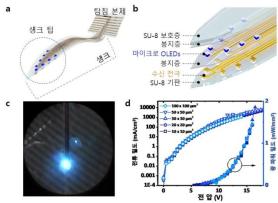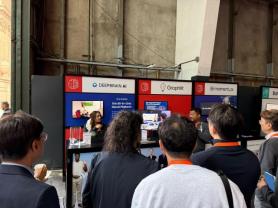
[Courtesy of KAIST]
Transcranial-focused ultrasound stimulation (tFUS) is an effective non-invasive treatment method for brain disorders such as Alzheimer's disease, epilepsy, and Parkinson's disease. However, the therapeutic effects of ultrasound neuromodulation are not widely adopted because the current preclinical studies are anesthesia-dependent and head-fixed. Such conditions limit clinical translatability.
Currently, there is no ultrasound neuromodulation system that can monitor brain activities in real-time in freely behaving animals. Conventional methods require the target animal to be unconscious and unable to monitor brain activities in real-time. If the test subject is freely behaving, it will create electrical noise that would affect the result of the test.
The Korea Advanced Institute of Science & Technology (KAIST) said that its research team used microelectromechanical systems (MEMS) technology to design and produce a small and lightweight transducer capable of stimulating the brain and simultaneous neural recording. The device is the size of an adult finger digit and can be put on a rodent's head like a helmet.
Researchers also developed a closed-loop stimulation system that would deliver a series of ultrasonic stimulations to analyze the status of the sleeping rodent to apply ultrasonic stimulation when the rodent enters the state of non-rapid-eye movement (NREM) sleep. The system can stimulate the brain and monitor activities simultaneously without any electrical noises.
By using the MEMS and the closed-loop stimulation method to stimulate the prefrontal cortex of a total-sleep-deprived rat for 10 hours, the researchers found that the ultrasonic neuromodulation system helped the rodent maintain its short-term special memory while increasing the duration of REM sleep. Based on the studies, the researchers started developing a new upgraded system that can stimulate a very small area of the brain. KAIST said that the technology could pave a new road for the development of non-invasive techniques for the treatment of Alzheimer's disease, Parkinson's disease, and other brain disorders.
"Ultrasound monitoring technique is safe enough to be used on the monitoring of a fetus. It is a very attractive non-invasive treatment technique that can send focused beams to reach deep parts of the body," researcher Lee Hyun-joo said in a statement on November 10.
Copyright ⓒ Aju Press All rights reserved.




